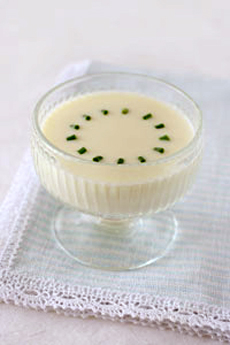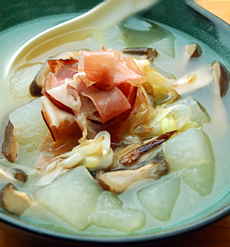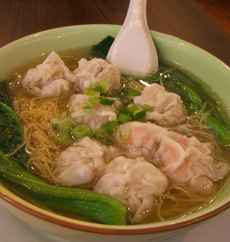
April 2010
Last Updated September 2025
|
 |
Soup Types: T To Z
Page 6: Tortilla Soup To Wonton Soup
This is Page 6 of a six-page soup glossary. It features tortilla soup, velouté, winter melon soup, wonton soup, and other soup-related terms from T to Z. There are thousands of soups in the world’s cuisines; terms featured are soups likely to be found in the U.S. Click on the black links below to visit other pages.
THICKENER
Starch thickeners are used to give body to vegetable soups. Arrowroot is elegant, but the most expensive of the group. Cornstarch goes in the other direction—inexpensive, and it adds a nice gloss to the soup (that’s why Chinese soups are so glossy). Flour is a classic thickener, but add too much and the soup tastes floury. We have to mention blood (the blood of the animal whose meat is used), which has been a classic thickener since the dawn of cooking—but not in the U.S. Other ingredients commonly used to thicken soups and broths include rice and grain. Bisques are made from puréed shellfish, fruit, or vegetables thickened with cream. Cream soups are thickened with béchamel sauce. Veloutés, the richest soups, are thickened with eggs, butter, and cream.
TORTILLA SOUP
A Mexican specialty; think of a chicken enchilada turned into a soup of succulent chicken and sweet corn, topped with crunchy tortilla chips. Here’s a recipe.
Although the exact origin of tortilla soup is unknown, it’s particularly common in the Mexico City area. Traditional tortilla soup is made with chicken broth combined with roasted tomatoes, onion, garlic, chiles, and tortillas, cut into strips and fried. It’s served with pieces of pasilla chiles, chicharrón, avocado, queso panela, lime, and Mexican crema.
|
|

Tortilla soup (photo © Cabot Creamery). |
TURTLE SOUP
Potage à la Tortue Claire—clear turtle soup, an Escoffier recipe—was a mainstay of fine dining in the U.S. from the colonial era through the mid-20th century. It was once such a hallmark of fine dining that it was served at Abraham Lincoln’s inauguration, and was a favorite of President William Howard Taft. It was served at the most prestigious restaurants, including Delmonico’s in New York City. As with any dish, there are different executions, from a clear consommé with diced turtle meat to a tomato-based broth thickened with a medium-dark roux. In the U.S., it was always served with a glass of sherry to pour into one’s soup with a flourish.
Why did it disappear from U.S. menus?Prohibition eliminated the availability of sherry.
The rise of factory farming consolidated America’s meat production made it easier to process other meats.
Cute turtle characters appearing in the media created an unintended perception shift against the idea of eating them.
And most importantly, the green sea turtles used to make the dish were classified as endangered in 1973. While turtle enthusiasts switched to the more abundant snapping turtle, the recipe had run its course by the 1980s.
Turtle soup remains a delicacy internationally, particularly in China and Singapore.
|
|

This recreation of Escoffier’s turtle soup was made with farmed turtle meat, veal bones, chicken, vegetables (including rutabaga), plus chervil, micro orchids, starflowers, and fennel flowers (photo © Alineaphile).

A simpler version (photo Rodrigo Ortiz | Unsplash).
|
VELOUTÉ
The richest, thickest soup of all, velouté is a broth—usually chicken or shellfish—thickened with eggs, butter, and cream. Velouté, meaning velvety, is the adjectival form of the French word for velvet, velour.
Velouté is also one of the classic French mother sauces. It’s made from a white stock (chicken, fish, or veal) thickened with a blond roux (butter and flour cooked without browning).
|
|

Velouté, with truffles and white truffle oil (photo © Oliviers & Co.). |
|
VICHYSSOISE
Vichyssoise (pronounced vee-shee-SWAZ) is a cold potato and leek soup, served in hot weather. It was invented at the Ritz-Carlton Hotel in New York City in 1917 by Louis Diat, a French chef born in a town near Vichy, based on a potato and leek soup of his childhood that he would cool off during the summer by pouring in cold milk. The soup was first called Crème Vichyssoise Glacée. Culinary historians point out that the French chef Jules Gouffé published a similar recipe with potatoes, leeks, chicken stock, and cream in his book, Royal Cookery, in 1869, but he did not serve it cold. Here’s the recipe and more history of the dish.
|
|

Photo courtesy UmamiInfo.com. |
|
WINTER MELON SOUP
Chinese winter melon soup is a savory soup with a chicken or vegetable stock base, shiitake mushrooms, green onions, and ham. Like the tomato, the winter melon is a botanical fruit, but by flavor profile, it is a vegetable. While the melon is simmered in the stock, winter melon soup can be an elaborate presentation, with the soup presented inside a whole winter melon that has been steamed for hours. The skin is decoratively cut, so that what is presented is a decorative centerpiece, smaller than a medicine ball, larger than a soccer ball, filled with soup. The flesh of the melon is scooped out with the soup. You can find a recipe at AppetiteForChina.com.
|
|

Chinese Winter Melon Soup. Photo courtesy AppetiteForChina.com. |
|
WONTON SOUP
A Cantonese cuisine favorite, wonton refers to the dumpling in the soup. The dumplings are typically boiled and filled with minced pork, but there are regional variations. Many restaurants that include the soup as part of the meal serve a minimalist wonton—the broth, a few dumplings, and sliced green onions. But a fully-packed bowl of soup can include noodles, bok choy, slices of chicken, shrimp, and anything that appeals to the culinary sense of the chef.
|
|

Wonton Soup. Photo courtesy Wikimedia. |
Go To The Article Index Above
Lifestyle Direct, Inc. All rights reserved. Images are the copyright of their individual owners.

|









